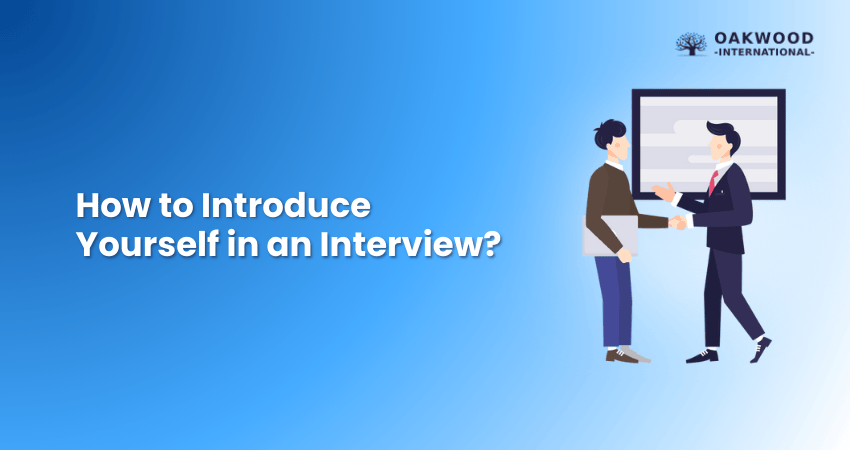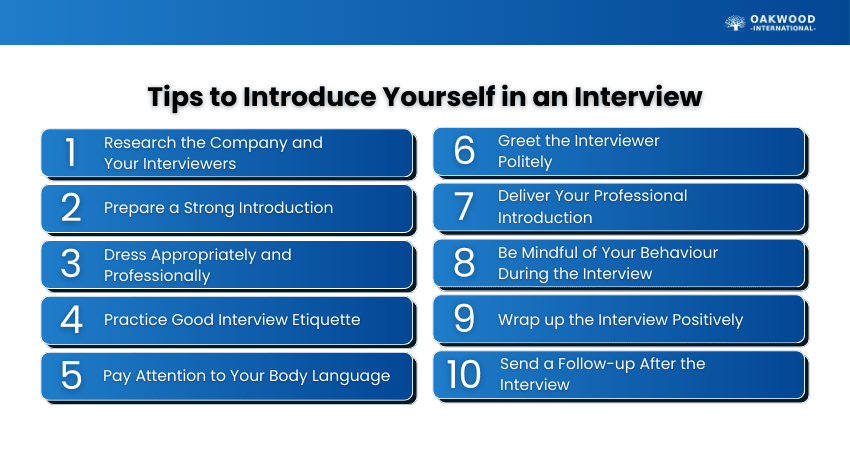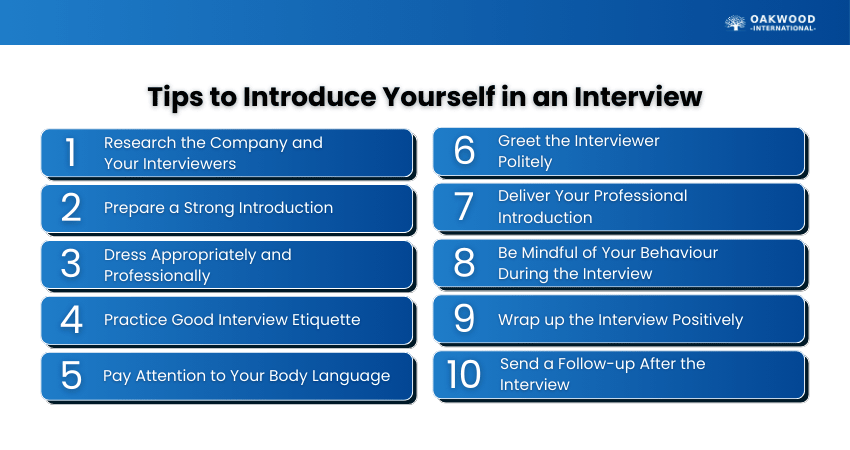Table of Contents


You sit across from the interviewer, and suddenly the question comes: “So, tell me about yourself.” For a second, your mind goes blank. Should you talk about hobbies, mention your education, or dive straight into work experience? The truth is, your introduction is your spotlight moment, and it sets the tone for the rest of the conversation.
In this blog, you’ll learn How to Introduce Yourself in an Interview. We’ll share practical tips, provide complete introduction examples, guide you on preparation, and suggest easy phrases you can use to make a lasting first impression.
Table of Contents
1) Tips on How to Introduce Yourself in an Interview
2) Examples of Complete Introductions in an Interview
3) Tips on How to Prepare for an Interview
4) Example Phrases for an Interview Introduction
5) Conclusion
Tips on How to Introduce Yourself in an Interview
How to Introduce Yourself in an Interview is your chance to make a strong first impression. Keep it short, friendly, and confident so the interviewer quickly sees your personality and skills. To help you do this well, here are some simple tips for How to Introduce Yourself to the Interviewer:
1) Use a Proper Greeting
A polite greeting shows respect and starts the conversation on a positive note. Always smile and use “Good morning” or “Good afternoon” based on the time of day. This makes you look confident and professional right from the start.
Example: “Good morning, it’s great to meet you today.”
2) Pay Attention to Body Language
Your body language speaks louder than words in an interview. Sit up straight, keep eye contact, and smile to show confidence. Do not cross your arms or fidgeting, as this can make you look nervous.
Example: Sitting tall, smiling, and saying, “I’m happy to be here.”
3) Start with a Unique Opener
A unique opener helps you stand out and be remembered. You can share a short positive fact about yourself that connects with the role. Keep it professional but also personal enough to make you relatable.
Example: “I enjoy learning new digital tools that make work faster and more organised.”
4) Show You're a Problem Solver
Employers like candidates who can face challenges with solutions. Briefly explain how you enjoy solving problems and improving things. This shows you’re proactive and valuable to any team.
Example: “In my previous job, I created a simple checklist that reduced errors in reports.”
5) Highlight Your Educational Background
Your studies or training show the foundation of your skills. Share your degree, diploma, or course in a clear and simple way. Focus on how it connects to the job you’re applying for.
Example: “I studied Business Management, which taught me teamwork, planning, and leadership skills.”
6) Mention Relevant Skills and Certifications
Talk about the skills or certificates that make you a strong fit for the role. Pick the ones most related to the job requirements. This proves that you have both knowledge and practical training.
Example: “I completed a Project Management certification that helps me organise tasks and meet deadlines.”
7) Connect Your Background to the Role
Show how your past work or life experiences link directly to the position. Employers like to see that you already have useful skills that fit their needs. Keep the connection clear and simple.
Example: “I worked with clients every day in my last role, which built my communication skills for this job.”
8) Share Your Career Goals
Talking about your targets shows that you are ambitious and motivated. Keep your goals realistic and aligned with the role you want. This helps the interviewer see you as someone planning for growth.
Example: “I aim to become a team leader in the next few years, and this role is a good step.”
9) Keep it Brief
A long introduction can lose the interviewer’s attention. Keep it short, clear, and to the point, lasting about one minute. This shows you respect their time and can communicate effectively.
Example: “Hello, I’m Sarah. I studied accounting, completed a finance internship, and I’m excited about this role.”
Transform reviews into growth with our Performance Appraisal Training – Join now!
Examples of Complete Introductions in an Interview
A complete introduction is a short one-minute summary of your name, background, skills, and interest in the role. Here are examples for fresh graduates and experienced professionals.
1) For Fresh Graduates
“Good morning, my name is Ankit. I recently finished my degree in Computer Science. During my studies, I worked on different projects, like a mobile app for students. I enjoy solving problems and coding, and I’m excited to start my career as a Software Developer. I like this job because your company uses technology to make life easier.”
2) For Experienced Professionals
“Hello, my name is Rachel. I have seven years of experience in digital marketing, mainly in content and Social Media. In my last job, I helped grow website traffic by 40% in one year. I enjoy working with teams and creating plans that connect with customers. I’m interested in this job because I believe my skills can help your company grow online.”
Tips on How to Prepare for an Interview
How to Introduce Yourself in an Interview starts with a smile, eye contact, and a confident greeting. Keep your answer short, around one minute, by sharing your skills, experience, and why you fit the role. This is just the first step; you should also prepare by researching the company, planning answers, and dressing smartly.

1) Research the Company and Your Interviewers
Before the interview, find out about the company. Visit their website, see what they do, and read about their values. If you know the interviewer’s name, check their role on LinkedIn. This shows you are ready and prepared.
Example:
“I admire how your company focuses on sustainability, and I’m excited about this opportunity.”
2) Prepare a Strong Introduction
Plan a short and clear introduction. Share your name, your background, and why you are at the interview. Keep it simple and under one minute. Practise a few times so it sounds natural and confident.
Example:
“Hello, my name is Priya. I recently completed my degree in finance, and I’m excited to start my career in accounting.”
Improve your team’s efficiency with our Workforce Resource Planning Training – Join now!
3) Dress Appropriately and Professionally
Your clothing also reflects professionalism and creates an impression. Wear something neat and suitable for the company. For formal jobs, go for business wear. For creative roles, you can be a little less formal but still smart. Always keep your grooming and shoes tidy.
Example:
For a corporate job, wear a blazer and formal shoes. For a design role, wear smart casual with clean shoes.
4) Practice Good Interview Etiquette
Show respect and good manners from the start. Arrive on time, switch off your phone, and be polite to everyone you meet. Even small actions before the interview room count.
Example:
Arriving 10 minutes early and greeting the receptionist with a smile makes a strong first impression.
5) Pay Attention to Your Body Language
Your body language shows how confident you are. Sit straight, smile gently, and look at the interviewer. Don’t cross your arms or look nervous. A simple, friendly handshake (if normal in your culture) also helps.
Example:
Sitting up straight, keeping eye contact, and nodding while listening makes you look engaged and confident.
6) Greet the Interviewer Politely
Start with a warm greeting. Keep it short and friendly. Use the interviewer’s name if you know it. A polite greeting makes them feel respected and sets a positive tone.
Example:
“Good morning, Mr. Sharma. It’s a pleasure to meet you.”
7) Deliver Your Professional Introduction
This is your chance to say who you are. Speak slowly and clearly. Share your name, education or work background, and a skill that matches the job. Keep it positive and short.
Example:
“My name is Sarah. I have three years of experience in marketing, and I enjoy creating Social Media campaigns that connect with people.”
8) Be Mindful of Your Behaviour During the Interview
The way you act also introduces you. Listen carefully, don’t interrupt, and answer politely. Even if you feel nervous, stay calm and professional. The interviewer notices your behaviour all the time.
Example:
Smiling, listening closely, and waiting for your turn to speak shows respect and professionalism.

9) Wrap up the Interview Positively
End the interview with gratitude and interest. Thank the interviewer and remind them why you are excited about the role.
Example:
“Thank you for meeting me today. I am very interested in this job and look forward to the chance to work here. I believe my skills can make a positive contribution to your team.”
10) Send a Follow-up After the Interview
Always send a thank you mail within 24 hours. Keep it short and polite. This shows you are professional and truly interested.
Example:
“Dear Ms. Lee, thank you for taking the time to meet with me. I enjoyed learning about the role and your company. I look forward to hearing from you.”
Develop your skills in Talent Management and lead your organisation. Join our Talent Management Training now!
Example Phrases for an Interview Introduction
Here are some ready-to-use phrases you can practise:
1) General Self-introduction
A general self-introduction is a short way to tell your name and background. Keep it simple and professional.
Examples:
“Hello, my name is [Name]. I recently graduated from [University] with a degree in [Subject].”
“Good morning, I’m [Name], and I have worked in [Industry] for [X years].”
2) Highlighting Work Experience
You can also Introduce Yourself by sharing your work history and what you learned from it. This shows your skills and achievements.
Examples:
“I have over five years of experience in customer service, where I learned how to handle clients and solve problems quickly.”
“In my last role as a Project Manager, I led a team of ten people and delivered projects on time.”
3) Emphasising Career Goals
Some introductions highlight where you want to go in your career. This shows ambition and long-term interest.
Examples:
“I am looking to grow my career in finance, and I believe this role is a great step forward.”
“My goal is to become a skilled data analyst, and I see your company as the best place to achieve that.”
4) Showing Enthusiasm
You can also show excitement and passion for the job. Enthusiasm makes a strong impression on interviewers.
Examples:
“I’m really excited to be here today and learn more about this opportunity.”
“I admire the work your company does, and I’m eager to contribute.”
5) Demonstrating Flexibility and Transferable Skills
If your background is different from the role, focus on transferable skills. This shows you can adapt and bring value in new ways.
Examples:
“Although my degree is in history, I developed strong research and writing skills that I can use in this role.”
“I have experience in both teaching and training, which has made me adaptable and quick to learn new skills.”


 Back
Back



 Back to Catagories
Back to Catagories





 + 44 7452 122728
+ 44 7452 122728










